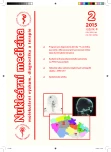-
Medical journals
- Career
Software „ActivityDetermination“ for determination of activity of 131I for treatment of patients with differentiated thyroid cancer
Authors: Jaroslav Zimák 1; Petr Vlček 1; Kateřina Personová 1; Kateřina Táborská 1; Jan Vejvalka 1,2
Authors‘ workplace: Klinika nukleární medicíny a endokrinologie, 2. LF UK a FN v Motole, Praha 1; Oddělení informačních systémů, 2. LF UK a FN v Motole, Praha 2
Published in: NuklMed 2015;4:22-27
Category: Original Article
Overview
Thyroid cancer is the most frequent endocrine malignity and its incidence grows in Europe as well as in other parts of the world in recent years. The increase in incidence is seen mainly in differentiated microcarcinomas (size to 10 mm) and low-risk carcinomas (up to 20 mm). Treatment of differentiated thyroid cancer includes thyreoablation by iodine 131I that should induce long-term remission or complete healing of the patients. Recent developments in therapy of thyroid carcinomas aim to decrease the amount of radioiodine administered to patients – to implement more efficient, better targeted, less invasive and cheaper methods that result in the best possible quality of patients’ lives. We created a computer program that serves for individualized optimization of administered radioiodine activity based on clinical and laboratory data of patients at the Department of Nuclear Medicine and Endocrinology. The algorithm of the program reflects the current practice in radioiodine administration; its correct implementation was tested on a sample of current patients as well as on retrospective data from the research database of our clinic.
Key Words:
thyroid cancer, iodine treatment, software
Sources
1. Hegedüs L. Clinical practice. The thyroid nodule. N Engl J Med. 2004;351 : 1764-1771
2. Pellegriti G, Frasca F, Regalbuto C et al. Worldwide increasing incidence of thyroid cancer: update on epidemiology and risk factors. J Cancer Epidemiol. 2013;2013 : 965212
3. Lukas J, Drabek J, Lukas D et al. The epidemiology of thyroid cancer in the Czech Republic in comparison with other countries. Biomed Pap Med Fac Univ Palacky Olomouc Czech Repub. 2013;157 : 266-275
4. Blumhardt R, Wolin EA, Phillips WT et al. Current controversies in the initial post-surgical radioactive iodine therapy for thyroid cancer: a narrative review. Endocr Relat Cancer 2014;21:R473-R484
5. Heřmanská J, Zimák J, Jirsa L et al. Initial Experience with Software System JODNEW for Evaluation Biophysical Characteristic Related to Treatment of Carcinoma of Thyroid Gland by 131I. In Radiation Hygiene Days. Conference Proceedings. Bratislava, GRAFIT3, 1998, 82–86
6. Heřmanská J, Kárný M, Zimák J et al. Improved correspondence beeween projected and measured doses of I-131 using the new kinetic model. Eur. J. Nucl. Med. 2000; 27 : 917
7. Heřmanská J, Kárný M, Zimák J et al. Improved predicition of therapeutic absorbed doses in the treatment of thyroid carcinoma. J. Nucl. Med. 2001;42 : 1084-1090
8. Lassmann M, Hänscheid H, Chiesa C et al. Dosimetry Committee series on standard operational procedures for pre-therapeutic dosimetry I: blood and bone marrow dosimetry in differentiated thyroid cancer therapy. Eur J Nucl Med Mol Imaging 2008; 35 : 1405–1412
9. Sgouros G, Kolbert KS, Sheikh A et al. Patient-specific dosimetry for 131I thyroid cancer therapy using 124I PET and 3-dimensional-internal dosimetry (3D-ID) software. J Nucl Med 2004;45 : 1366-1372
10. Eschmann SM, Reischl G, Bilger K et al. Evaluation of dosimetry of radioiodine therapy in benign and malignant thyroid disorders by means of iodine-124 and PET. Eur J Nucl Med Mol Imaging 2002; 29 : 760-767
Labels
Nuclear medicine Radiodiagnostics Radiotherapy
Article was published inNuclear Medicine

2015 Issue 2
Most read in this issue- Incidental detection of tumor duplicity on bone scan – SPECT/CT
- Radiation protection of medical staff on PET/CT departments
- Software „ActivityDetermination“ for determination of activity of 131I for treatment of patients with differentiated thyroid cancer
Login#ADS_BOTTOM_SCRIPTS#Forgotten passwordEnter the email address that you registered with. We will send you instructions on how to set a new password.
- Career

